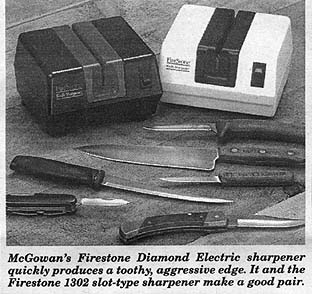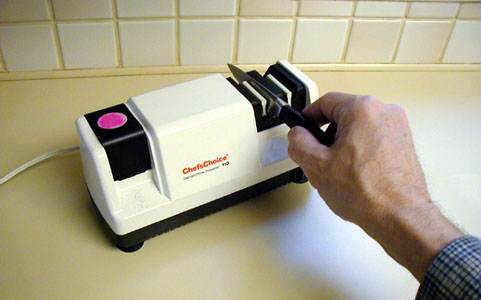A PRIMER ON KNIFE SHARPENING - Chapter 2
by Steve Bottorff
color photographs by Carol Butz
CONTENTS
CROCK STICKS
Ceramic rod sharpeners, also known as crock sticks, are completely
different than bench stones. The rods are held in a vee at a predetermined
angle, and the blade is brought down against them in a slicing motion. You
can manually make deviations from the set angle by tilting the blade.
Unfortunately most of these sharpeners come with only one grade of rods
so they have limited use. An exception is the Tri-angle Sharpmaker from
Spyderco. Their deluxe set comes with two pairs of ceramic rods, medium
and fine, and a pair of medium diamond sleeves for pre-sharpening. A
fishhook groove, a scissors position and a flat position extend the
Tri-angle Sharpmaker for special uses. The Tri-angle Sharpmaker comes with
a good instruction book.
Lansky makes a handy folding ceramic rod sharpener called
Fold-A-Vee. It folds for easy carrying and features two angle
settings for fillet and hunting knives.
SLOT GADGETS
There are a whole lot of gadgets on the market that promise easy
sharpening. I have tried a lot of them in my quest. Theoretically
with slot-type gadgets you just draw the knife through a slot a few times
and it will be sharp. Many are worthless gimmicks, but some are worth
considering.
The most primitive type of slot gadgets uses a pair of tungsten carbide
tool inserts set at an angle. A variation uses a set of overlapping
carbide wheels. These literally scrape metal away from the edge, and
leave a sharp, but somewhat ragged, edge. This type shapes the
initial bevel but provides no way to hone or steel the edge. I
bought one and it ended up in my junk box. Benefit from my
experience and save your money.
More refined slot gadgets use two sets of ceramic wheels or rods, one
medium and one fine. This type hones well but is limited in its ability to
sharpen. In the TwinSharp from J. A. Henckels these wheels are in the same
slot. In theory you might use both in one pass, but in practice I
found that changing your hand position changes which set of wheels
contacts the blade. Knowing this, you can sharpen and hone
separately. The TwinSharp is handy for touch-ups and I used it
between regular sharpenings until I gave it to a friend.

The FireStone 1302 Knife Sharpener from McGowan Manufacturing is also a
two stage setup, but with sets of four interleaved medium and fine wheels,
each set in its own slot. This makes it more convenient if the knife
needs more sharpening than honing or vice versa. The Firestone would
be especially handy if you own their electric sharpener, reviewed
below. McGowan also makes a variety of other manual sharpeners
marketed to fishermen and bow-and-arrow hunters. These feature
additional tools like a broadhead wrench, fishhook sharpener and line
cutter. Like golf spike tools and shotgun choke removers that are
often featured on specialty knives, these tools are indispensable when you
need one. I picked up a FireStone SharpPocket because it was winner
of a product design competition. This is a single stage sharpener
with only medium grit ceramic wheels. Instructions say to go light
on the last few strokes to polish the edge. In my opinion the
ceramic wheels are too coarse for a good edge, and they wobble. It
has joined my junk sharpener collection.
If you are going to benefit from a slot gadget, it must hone at an equal
or greater angle than your sharpening. The Chef'sChoice Model 450 uses
diamond stones at the same angles (22.5 and 25 degrees) as the final two
stages of their electric sharpeners. I keep one in a kitchen drawer
for use between regular sharpenings on my Chef'sChoice Model 110.

For about $2, the Normark sharpener is a best buy.
The Normark knife sharpener is an inexpensive slot gadget that can be
found at a sporting goods store next to Normark's fillet knives. It
has two sets of ceramic rods set at 20 degrees. The medium gray rods
sharpen and the fine white rods hone. I have used it to restore a
slightly dull blade to shaving sharpness. It costs about $2, so it
surely is the Best Buy. The Normark's 20 degrees is perfect for touching
up a fillet knife where the initial edge was 17 or 18 degrees.
There is one class act in every category, and the Meyerco Sharpen-It is
it for slot gadgets. Designed by Blackie Collins to be so simple
that it could be used on horseback, the Sharpen-It features tungsten
carbide wheels for the first stage and fine ceramic wheels for the
second. The ceramic is so hard and fine-grained that it is more like
using a steel. With this combination, the Sharpen-It performs well
at both sharpening and honing.
Unlike other slot devices, the Sharpen-It adds a third wheel to each
set, giving two slots, and shapes them so that they sharpen one side of
the blade at a time. This setup allows you to vary the bevel angle
somewhat. Drawing the knife through at an angle decreases the bevel
angle and gives a more razor-like edge. Since it is assembled with
tamper-proof screws, I could not measure the bevel angles, but this
information is less important because you won't have to use it with
another sharpener to get complete results.
Also unlike others, the Sharpen-It can be used equally well
left-handed. It is so compact when closed that it can be carried in
the watch pocket of your jeans. The unit well built and sturdy, and
features a tapered hone for serrated blades. A less expensive model
is available without the tapered hone.
ELECTRIC SHARPENING MACHINES FOR
HOME USE
Cheap electric knife sharpeners such as those found on can openers grind
aggressively but with little control of angle or depth. I've seen many
knives ruined by them and they have given electric sharpeners a bad
reputation. Here are two electric sharpeners worth considering for
household use.
The FireStone Diamond Electric sharpener from McGowan is a fast machine
that produces a toothy, aggressive edge with just a hint of a burr. I
prefer a more refined edge and the Firestone manual sharpener reviewed
above is just the tool to refine it. The instructions don't say so, but
the designer recommends pulling the knife through the wheels a few times
with the machine turned off to align the edge, effectively using it as a
manual sharpener. But this edge, right from the machine, will slice
right through a ripe tomato while a fine edge may not.
The manufacturer specifies 23-degree bevels on all their FireStone
sharpeners, but I measured 18 to 19 degrees on the electric sharpener and
21 to 22 degrees on the manual sharpeners. The18-degree hollow ground edge
would be another reason for the aggressive cutting. The FireStone
manual sharpener would hone it to a longer-lasting angle.
Note: there is no generally accepted method for measuring bevel angle of
hollow ground blades. I like to measure the wheel diameters and
spacing and calculate the angle at the edge by trigonometry. This
manufacturer suggests measuring the average angle of the entire bevel, but
that varies with blade thickness. My low number is the angle at the
edge, and my higher number is the average angle for a blade with 0.020
thickness at the back of the bevel, typical of a hunting knife.

The FireStone design features four interleaved, counter-rotating wheels
like commercial machines, but without the adjustable angles that make the
commercial machines so expensive. The wheels are 220 grit
diamond-impregnated ceramic. I found it difficult to sharpen close
to the bolster with the FireStone electric sharpener and, because it
grinds so fast, you cannot play around much without grinding a swale into
the blade. The instructions say you might need up to 10 passes on a
new blade, but I found that every blade I tried was sharpened in a single
pass and begin to show loss after only 3 passes. I suspect that
repeated use of this sharpener would reduce knife life or require
professional sharpening to re-shape the blade. I would prefer that
this sharpener used finer stones and a slower speed.
McGowan has updated the Firestone
electric sharpener. It is now called the DiamondStone and comes with
finer stones. My few uses of it indicate it works as well as the
Firestone and produces a better edge.

The Chef'sChoice 110 features three sets of diamond hones, and does a
great job of sharpening.
EdgeCraft's Chef'sChoice Model 110 uses 3 sets of diamond hones and each
sharpens at a different angle. The first stage is very aggressive,
grinding even faster than the FireStone, but it is only used once to
pre-shape the bevel. From then on you use the second and third
stages (sharpening and honing) only. The final honing is at a very
sturdy 25 degrees, which will give very long edge life. (The Model
310 is similar, but with only the final two stages. I have not used
one.)
The Chef'sChoice is my recommendation in this class, with one caution -
it has a tendency to scratch the sides of a blade, so I can't recommend it
for collectible knives, but it is great for working knives.
The
latest Chef'sChoice sharpener is the model 130. It is identical
to the 120 except the second stage has been replaced with a steel,
giving you the option of having a steeled edge without mastering
steeling. Guides make the task foolproof, and the steel segment
is threaded so that as the small section you are using wears out you
can turn the screw a notch to a new section. If you have a CC
110 or 120 and want a bargain upgrade, just buy the Chef'sChoice 470
SteelPro manual sharpener - the manual version
of the CC 130 second stage.
Company and product names are trademarks of their respective companies.

